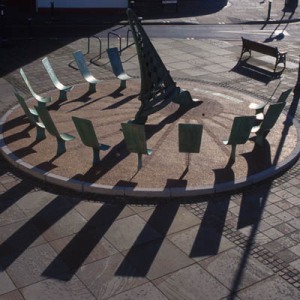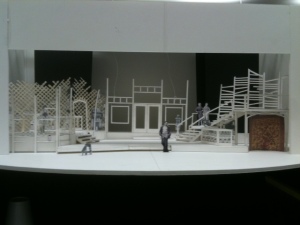
So I went outside yesterday, a novel concept right? It was so beautiful and I wanted to walk to the grocery store. I went and picked up some of my favorite things for lunch and dinner and walked back home. I took many short breaks to the outdoors today while I was staring at my computer screen drafting. Each time I went outside, everything looked different. After thinking about it for a second, I realized that the sunlight was changing the shadows and creating different looks. I noticed them because I do not get to regularly look outside at my apartment during daylight. My mind took me back to elementary school where we learned about making sundials. We took sidewalk chalk and make a circle. Using a watch as a guide, a child went out at every hour to create the mark for the hour. It never occurred to me then, but today I wondered…how did the first sundials get created? There wasn’t a Timex on someone’s wrist to tell them when to make the next mark. Being a designer, I assume that it was a simple geometric equidistancing of lines along the face of a circle. They distinguished days by the sun and the moon. But why do we use twelve? Why not twenty four marks for the twenty four hours in our days? Why not count our hours by what we now consider to be 30 minutes. 48 hours could effectively become only 1 day. It’s at this point that my mind beings to race and the sound of my internal monologue begins to sound like jibberish because there are various trains of thought passing through the same tunnel. I silence myself, and literally staggered in awe of the relativity of our concept of time. Just like words, we needed something to help us live our lives and we create tools to do so. The clock was created to help us synchronize and mark our lives. I know when I’m required to show up for a meeting because the other persons(s) have agreed to meet at the same arbitrarily measured unit of time. We almost subconsciously choose to follow these rules about time.
How much of this do we do when it comes to the Bible? The sundial was a tool to help mark moments in the day. It helped to organize the community. As technology progressed, we got the watch and the digital watch. The technology and look have changed, but it essentially serves the very same purpose. Granted, the later versions have new features such as glowing, making sounds, etc., but ultimately, if I ask you what time it is you’ll tell me the answer based on the measurement from your timepiece.
The Bible is a record of God’s revelation to humans, it organizes our community of faith. Does it function as more than just a tool to bring them together? Some of the first books ever written for the Bible are an example of the Bible being written as a law for social order. Several of the first books of the Bible give lists of “dos” and “do nots.”
What would happen if the earth’s rotation changed? What if its orbit around the sun was altered? How would our perception of time change? What if the first sundials were created in Denmark or Alaska where “night” or “day” can last for weeks, even months?
I think these types of earth shaking changes have happened in our society. Postmodern thought has altered the way we perceive our world. Truth is no longer held in the central towers that also wield power over the people. We’ve realized that cross-pollination of ideas, ethnicities, and creeds has drastically altered the way we must engage the world. As a society we’ve eliminated “normal” from our vocabulary and replaced it with “average” so as not to centralize our benchmark as the white, european, heterosexual male.
How then should Christians respond? Recently in a blog conversation about music in the church, I arrived at the topic of “dressing up” Christianity for the culture. This is what I said:
I think that “dressing up our faith” is exactly the problem. I’ve heard so many youth and college pastors talk about making their ministry relevant. You know what they do? They serve coffee and sometimes wear TOMS or flip flops. I sit back and wonder…THAT’S what you call relevant?! Coffee…it’s not only instant in and of itself…it’s instant relevance too! I think that Christianity is SO life-encompassing that if we allow the symbols, rituals, and practices of our faith to exist and take on tangibility that the very FORM of our faith will change.
Evangelical Christianity is a 50 year old man (gender exclusion intentional) who’s prime in life occurred in the 1970’s. This man doesn’t want to be un-cool so he tries to wear what everyone else is wearing, do what everyone else is doing. In essence, he’s a raggedy dress form with contemporary clothes sitting in a store window for all to see. No one is buying.
Christianity has been unable to cope with the radical societal transformation that postmodernism has brought into the world. From its roots in Mesopotamian pantheism to about the 1950’s, YHWH has existed in a world that views truth and power as centralized entities. When postmodernism began to decentralize our idea of truth (as a society) Christianity wasn’t too threatened. Those crazy existentialists and postmoderns were a small group of idiots that nobody really believed. Then 9-11 happened. Our society was fragmented and broken, people didn’t know who to believe anymore. The news stations became more comedy while our comedy became more like news broadcasts. The church is still trying to function under the archaic ideas of truth that have held it together for thousands of years, yet it is engaged in a battle that it will not win. People are gradually defecting from the church because its ideas are inconsistent with the truths observed in the natural world.
All that…and we think COFFEE will fix it? For Christianity to survive, the practices, symbols, core doctrines, and rituals of the faith must be preserved in a way that allows them to live and breath and react to the culture around them. I’m not suggesting total relativity, but a more relative perspective than has been valued in the past. I think God can change, I think God can change God’s mind…I think we need to seek the living God for new revelation of truth. I don’t think the canon of the Bible is closed. I think that art is the perfect medium for God to reveal God’s self. I think the artists should create and we should see what comes of it. Perhaps God will hear our cries for new revelation.
The full link to this conversation is here: http://popparables.com/2011/02/in-your-words-can-secular-music-be-used-for-worship/#disqus_thread
What do you think? Why do Christians accept a closed Biblical canon? Why can we not move past the archaic ideas that force us to combat society instead of engaging it with our faith?





